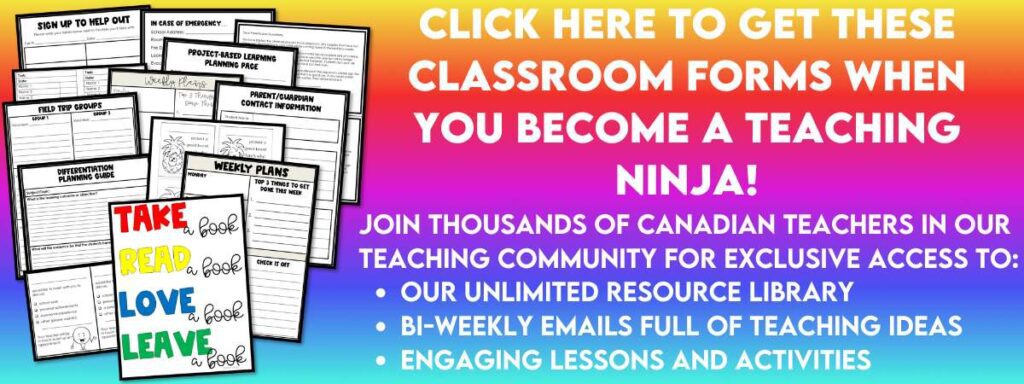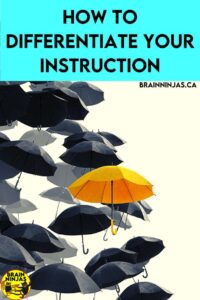
You have a complex classroom full of complex behaviours and learning challenges. Do you worry about how to teach all of them to the best of your ability? Are you spending all your time trying to differentiate instruction but feeling like you’re spinning in circles not getting anywhere?
Differentiation means different things to different people. We’re here to work through the clutter and streamline the planning process. Then you can differentiate for the different learners you have in your classroom without spending all your time planning.
What is differentiation?
Differentiation means adjusting your lessons, assignments and assessments to meet the learning and behaviour needs of all of your students. Whew! What!?
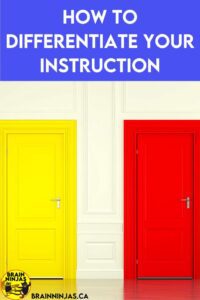
You are never going to be perfect enough to teach every single student in their own learning style every single day. It’s impossible. Unless you’ve found some magical way to write and teach thirty different lesson plans across six to eight different subjects each and every day, it’s not going to happen.
Differentiation does not mean every single student needs their own plan. It is not possible and unless each of your students is on an Individual Program/Education Plan, you cannot possibly plan for that. You can use a variety of strategies to differentiate instruction without coming up with thousands of individual lessons.
Thinking it’s too much for you? Check out this blog post called Debunking Five Differentiation Myths to get you back on track.
Three Basic Rules for Differentiation
- Your students are the focus of the learning-not you. If you are doing more work than them, you’re doing it wrong.
- You might need to let go of some of your expectations. This does not mean lowering your expectations. It means you might have to let go of what YOU want to make room for what THEY need.
- It will not be perfect. Learning to differentiate is a skill that takes time to develop. Eventually it will become as natural as breathing (well, sort of).
Differentiate Your Classroom Environment
We have a great Differentiation Planning Guide that you can download for free. It can be found in our Resource Library, along with many other general classroom forms to help you organize your classroom. Or we can send a copy directly to your inbox when you sign up for our email list. This guide includes instructions, examples and a template you can edit digitally and save.
If you have students who are fidgety, wiggly or need movement breaks, offer movement to all of your students. Either create natural breaks where everyone gets up and moves around or allow students to move when they need to.
Your classroom needs to be a place where students feel comfortable using what they need. No child wants to be the one that needs the special tool.
Introduce every tool to every student. This way, no one has to feel strange trying something out.
Here is how you do this:
Let’s say you have five wiggle cushions and twenty-eight students. Clearly, this won’t be enough for every student to try the wiggle cushion right away. Explain to the class that you have a bunch of tools to test. You want the students to give you feedback so the school can decide which tools are helpful.
Give the five stools to five students. Ask them to test them out for half a day (or a whole day). At the end of the day, use a class checklist and ask students to give it a + for liked it or – for didn’t like it. Use a / for halfway in between. Then, give the cushions to another five students and repeat the process until all the students have tried it. Now you’ll have an idea of which students liked it and thought it might work to help them focus.
Use this same process to try out fidget tools, Hokki stools, flexible seating options, different writing utensils, different seating arrangements, types of paper, technology tools or pretty much anything else you plan to introduce to your class all year.
And from our experience, we can tell you the novelty wears off pretty quickly. When the items are accessible to anyone, students learn to just use the things they need and don’t worry as much about others in the class because everyone uses everything.
If you’re looking for more information about implementing flexible seating be sure to read our post: Everything You Need to Know About Flexible Seating.
Another big way you can differentiate for all your students is simply through clear classroom expectations. Students need to know exactly what is expected of them. Be clear, concise and consistent.
Differentiate the Way You Deliver Content
If you only deliver content to your students in one method, you are probably not reaching all of your students all the time. Think about the different ways you can teach your students. Then think about which students would benefit from each method.
If you have students that struggle reading articles or textbooks, try reading aloud to your students. Keep the reading instruction as part of your reading lessons, but help overcome the problem in other subject areas. You can also record your voice or make a video of yourself reading the material. Students can replay and listen to it as many times as needed. Place these recordings in your Google Classroom or upload them to a private YouTube channel that only your students can access.
Create a Google Site or use your Google Classroom to place links to videos or online resources. Teach all your students how to access these bits of information.
Use a text-to-speech program like Google Read Write or Read Aloud to read information online with students. If you are a Google Chrome user, the app Mercury Reader helps simplify web pages from all the clutter like ads. Teach all of your students how to use these apps.
Mix It Up
Mix up your groupings. Teach groups of students at the same level together for specific lessons or subjects. A student who might be a group struggling with long division is not necessarily a student who needs help with fine motor practice or learning English. When you group students, try to make the largest groups possible with students who can assist each other while you teach another group.
Though Google Translate isn’t perfect, it is one way to get some basic instructions across to students who are new to English.
Keep it Age Appropriate
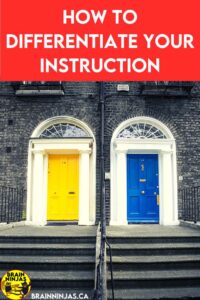
If you teach older students, be aware that giving them babyish looking work. This will counteract anything you teach them. This can happen when we go to our very helpful primary teachers (because that’s the correct reading level). As one grade four student once said, “No nine-year-old wants to read stories about farm animals and learning to tie your shoes.” Use a tool instead of providing low-interest material meant for five-year-olds.
Differentiate the Process in Which Students Complete Their Work
Some students work better in small groups, some need to be quiet, some need one on one assistance and others love to work at their own pace. Offering different choices for different activities will help all of your students learn different ways to work and refine how they choose the method that works best for them.
One big mistake we made was expecting that students should be working on different projects. They should be working on the same project but they have access to different tools to get the job done.
For example, if the whole class is working on projects to learn about homesteading in Alberta, then all students will be doing this same project. English Language Learners might be given some key vocabulary and taught about farming in Alberta. Students with reading challenges might be given their article read aloud to them. Those who need a challenge might be asked to explore how homesteads in Alberta differed from Ontario. Students who have difficulty getting their work done might have their project broken into small tasks that require a check-in with the teacher each day. Students who need to move might work at a standing desk or use the bicycle after every ten minutes of work.
You don’t change the project, you change the tools available for students to use to get the project done. Your role becomes the facilitator and students learn to advocate for what they need as learners.
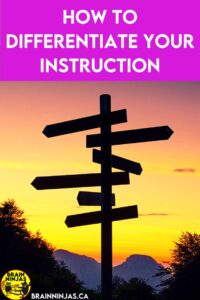
Differentiate the Way You Assess Student Understanding or Mastering of Skills
Yes, it is important that students learn to write tests, but you can learn a lot about what a student understands simply by observing them working on a task or by having a conversation with them.
Writing is just one way to find out what your students know and understand, but many students do not express their understanding as accurately in writing as they do in other ways like speaking. So, use writing as just one method for students to express their learning.
Allow your students to answer questions using a voice recorder. If you don’t have a device where students can record and send the recording to you, try Vocaroo.com It is an online voice recorder where students can email the recording or a link to a recording. We use this all the time for simple answers to questions. Students just put a link in their Google Doc or email and share it with us.
Use a classroom list to record skills. Just walk around your room while students are working to see which students are able to do each skill.
Take photographs or videos of students with the work they are producing to keep a record of what they know or can do.
Allow students to choose the way they express their learning. If you’re looking for more reading about giving students choices, check out this blog post: Why You Should Give Students Choices. Too many choices can be a problem, but start small with two choices and work your way up to more as your year progresses.

Where to Start Differentiating
You cannot differentiate for students you don’t know. You will need to spend some time getting to know your students and how they work best. This period of time is perfect for experimenting with different tools to see what your students need. It’s also perfect for doing some basic work to see what your students can and cannot do.
Get to know your students’ interests. If your students are interested in something, they will work at it with their very best, so it gives you a great frame of reference of what they are capable of doing.
You might want to have conversations with your students and get to know them with a learner profile. We have a set of questions in our store you can use to get you started in developing profiles. Once you have these learner profiles, you can best match your strategies to your students. Find the Learner Profiles and Surveys in our TpT Store ($USD) or our BN Shop ($CAN).
And we’ve got another post to help you differentiate without using all your time. It will deal with more specific problems for specific types of learning situations. Stay tuned!

